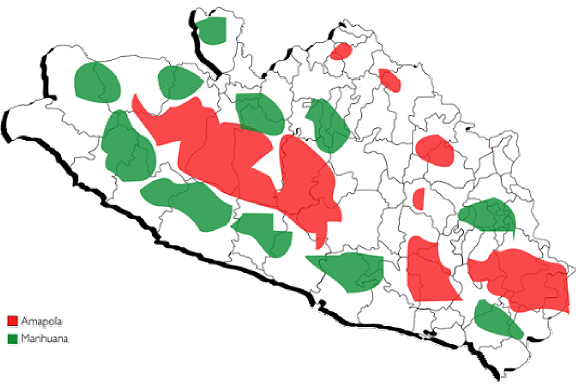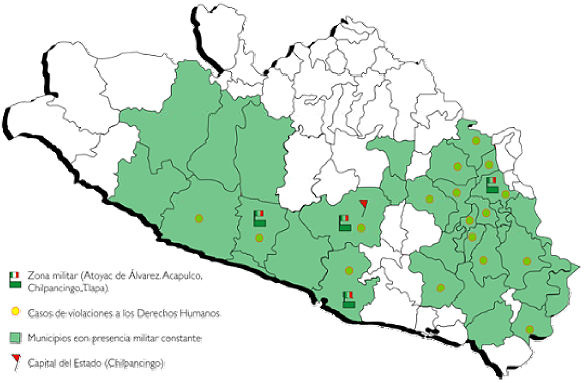S.I. 5 – Land
06/02/2012MIGRATION
06/02/2012S.I. 6 – Natural Resources
Guerrero is a state rich in natural resources. In its 63,794 km2 – 3.3% of the total national area, making it the 14th largest state – there are extensive beaches (its shore has an approximate length of 500 km), deposits of minerals and natural materials useful for construction, forests, jungles and abundant hunting and fishing. This is possible due to a complex physical composition, which comprises, among other things, a varied topography, diverse climatic regions, and a variety of rock formations.
Source : SEMARNAT 2005
… … …
Water / Hydroelectricity / Electricity
Some of the country’s most important rivers are in Guerrero, such as Río Balsas, Río Costa Chica, and Río Costa Grande. These rivers have a large number of dams used for irrigation as well as hydro-electric production.
For the year 2009, Guerrero contributed 9.8% of the country’s total electrical production, and 11.9% of Mexico’s total hydroelectric production. Meanwhile Guerrero is one of the states, together with Oaxaca and Chiapas, in which the fewest number of residents have electricity in their homes.
Sources: INEGI 2009
… … …
Minerals
- In Guerrero, there are deposits of alabaster, marble, silver, gold (11. 5% of the national production), lead and zinc (7.8% of the national production). Source: INEGI 2009
- Between 2005 and 2010, the federal government granted multinational companies mining concessions of 50 years each representing in total about 200,000 hectares of indigenous territories in the Mountain and Costa Chica of Guerrero. This way, those companies are enabled to carry out activities of exploration and open-pit mining, without taking into account the land rights and right to consultation of indigenous peoples. In these areas there are 42 mine sites, primarily of gold and silver. Source: Report XVI Struggling to build the dawn of justice, Human Rights Centre Tlachinollan, 2011.
… … …
Agriculture
59.8% of the surface area of the state is dedicated to agricultural, fishing, or forestry activities (Source: INEGI: 2010). The state produces sesame, coffee, bananas, cacao, papaya, mango, tobacco, lemon and corn. Logging is also varied, mainly pine woods, oak, cedar and mahogany.
35.7% of the population work in the primary sector (14.3% at a national level), thus occupying the second place at a national level following Chiapas. Source INEGI 2010
… … …
Biodiversity: Fourth in Mexico
Guerrero is considered the fourth most biodiverse state in the nation, after Chiapas, Oaxaca and Veracruz.
Source: SEMARNAT, 2010
… … …
Vegetation and Fauna
The state contains every type of vegetation common to temperate, dry tropical and coastal regions. It is calculated that there are more than 6,000 species of plants in the state, a fifth of the total (30,000) in Mexico.
The fauna of Guerrero is varied and one of the most important on a national level. 1,332 species of vertebrates have been documented (of which 326 are in danger of extinction and 114 of these are endemic to Mexico).
Even though Guerrero is one of the states with the greatest biodiversity (4th in the nation), its natural resources experience a high level of deterioration, reflected in the loss of native wild flora and fauna, deforestation, soil erosion, the depression of groundwater tables and the disappearance of rivers in the estuaries. These important natural riches are seriously threatened by the consistent destruction of ecosystems through factors such as the change of soil usage, forest fires (5th in the nation), the depredation of wild flora and fauna, the little or no management of solid wastes, and urban sprawl, among others.
Source: SEMARNAT
About 90% of Mexico is deforested, according to the UN Program for Environment (UNEP). Guerrero is third highest in the nation in regards to deforestation. Since the signing of the North Amercian Free Trade Agreement (NAFTA) 40% of Guerrero’s forests have been destroyed.
Source: Human Rights Center of the Mountain Tlachinollan 2011
… … …
Protected Natural Areas
Created by presidential decree, Protected Natural Areas are terrestrial or aquatic areas on national territory which are representative of various ecosystems in which the original environment has not been essentially altered and that produce ecological benefits that have been increasingly recognized and valued. Activities allowed in Protected Natural Areas are regulated by the General Law of Ecological Balance and Environmental Protection and its programs of ecological management. The Areas are subject to special rules of protection, conservation, restoration and development, according to categories established in the Law. The National Commission of Protected Natural Areas currently administers 174 federal natural areas on more than 25.3 millions of hectares (12.92% of Mexico’s total surface). Guerrero has 5 protected natural areas, including 3 national parks and two sanctuaries.
Source: SEMARNAT 2010
3 National Parks
National parks are areas which contain one or more ecosystems and are known for their scenic beauty, their scientific, educational or recreational value, their historical value, their flora and fauna, their potential for tourism or for other reasons related to general interest:
- El Veladero (Acapulco municipality)
- General Juan N. Álvarez (Chilapa municipality)
- Cacahuamilpa Grottoes (Pilcaya and Taxco de Alarcón)
2 Sanctuaries
Sanctuaries are areas established in zones characterized by a considerable wealth of flora and fauna or by the presence of species, subspecies or a rare habitat. They include canyons, plains, grottoes, caverns, natural wells, creeks or other topographic or geographic areas which must be preserved and protected:
- Playa de Tierra Colorada
- Piedra de Tlacoyunque


